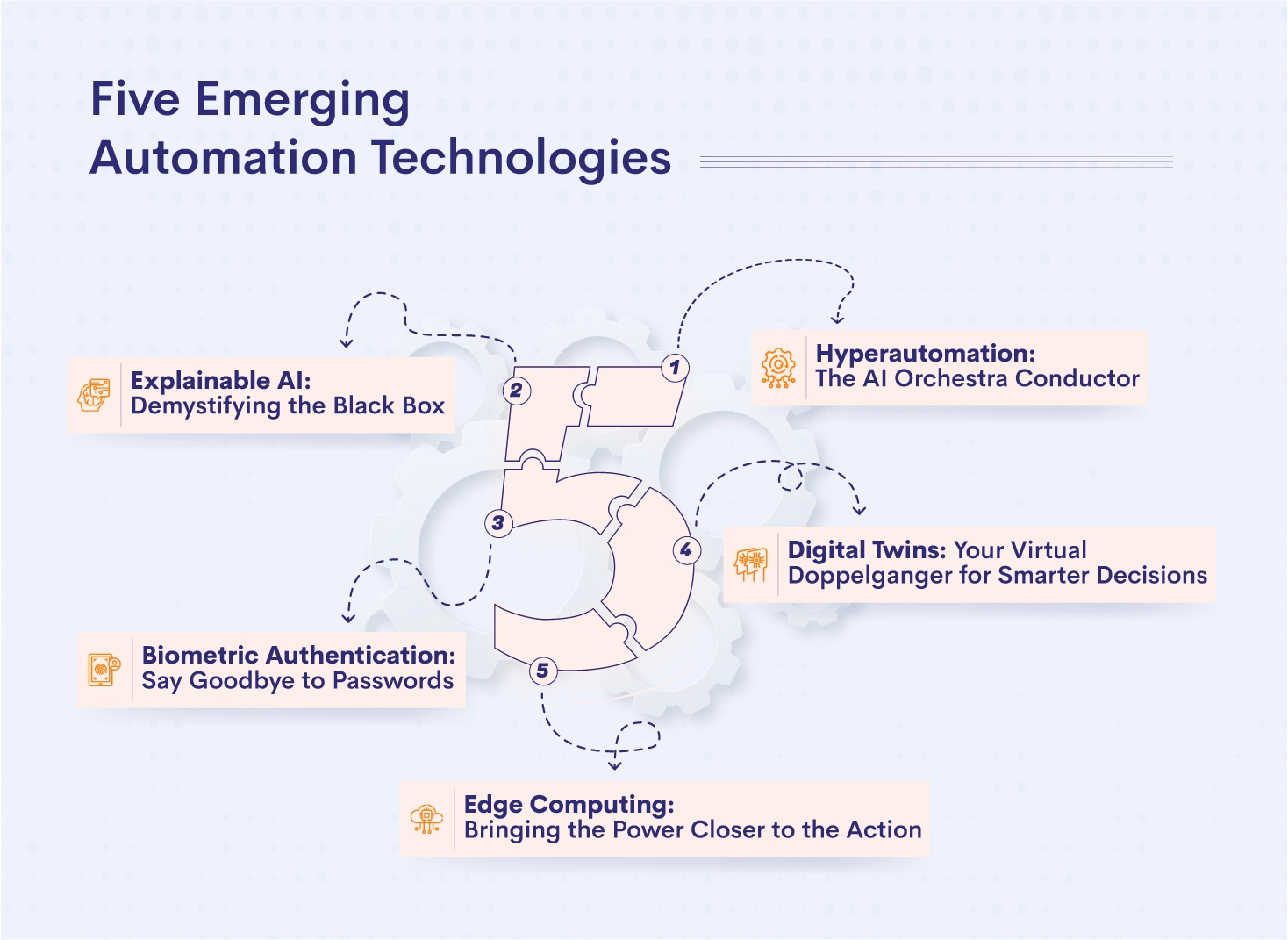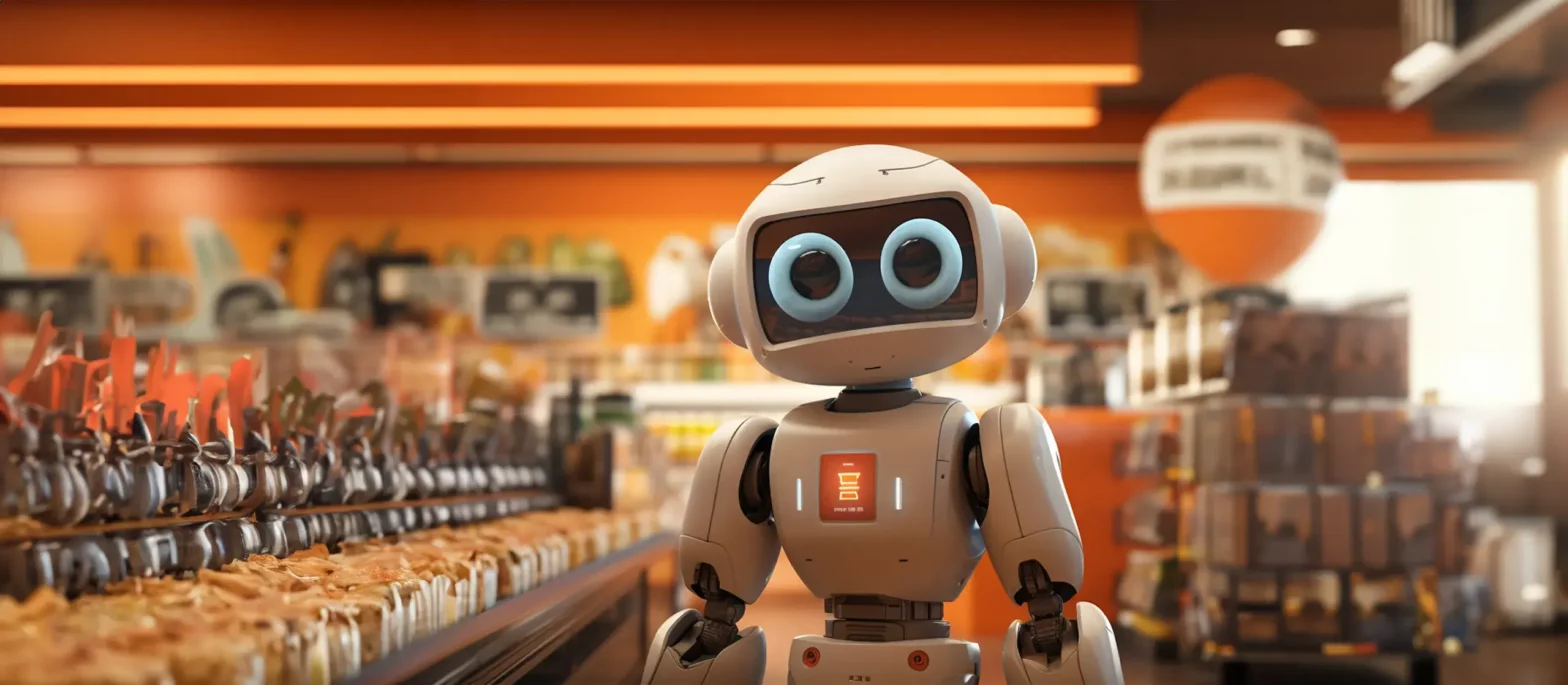- Automation
- December 19, 2023
Smarter, Faster, Better: Five Emerging Automation Technologies

- Automation
- December 19, 2023
Smarter, Faster, Better: Five Emerging Automation Technologies
The age of automation is upon us, and it’s not just about robots welding cars anymore. We’re on the cusp of a new wave of automation, driven by cutting-edge technologies that are poised to revolutionize everything from how we work to how we live.
So, buckle up, future-dwellers, and get ready to explore five emerging automation technologies that will have you saying “woah” faster than you can say “self-driving car”:

1. Hyperautomation: The AI Orchestra Conductor
Picture a world where your daily digital dance isn’t a chaotic solo act, but a graceful ballet choreographed by an invisible AI maestro. That’s the elegance of hyper-automation. Forget clunky bots tackling individual tasks; this is a symphony of efficiency, where AI, machine learning, RPA, and IoT harmonize, each instrument playing its perfect note to streamline your life. No more juggling calendar invites, wrestling spreadsheets, or chasing invoices.
Hyperautomation is the conductor, seamlessly orchestrating these digital tasks into a smooth, effortless crescendo of productivity. A significant emerging automation trend to watch out for in the future.
2. Digital Twins: Your Virtual Doppelganger for Smarter Decisions
Think of a digital twin as your virtual doppelganger in the digital world but with superpowers. It’s a real-time replica of a physical object or system, constantly mirroring its behavior and providing valuable insights. Digital Twins are yet another exciting example of the emerging automation trend. These digital doppelgangers are reshaping industries from buildings and factories to entire cities, allowing for optimization, predictive maintenance, and virtual testing before real-world implementation.
Imagine a city using its digital twin to simulate traffic flow and optimize traffic lights, leading to smoother commutes and reduced pollution. Or a factory utilizing its digital twin to predict equipment failures and schedule preventive maintenance, minimizing downtime and maximizing efficiency. These are just a glimpse of the possibilities that digital twins offer, making them a major trend to watch in the future of automation.
3. Edge Computing: Bringing the Power Closer to the Action
Picture the data journey you know: sensors whisper secrets to distant servers, decisions lag like dial-up, and real-time feels like an illusion. This is the bottleneck of traditional data processing. But fear not, for an emerging automation trend such as edge computing is rewriting the data playbook. It flips the script, bringing the processing power right to the source, like a nimble mind at the edge of the network.
Imagine a self-driving car, whizzing through traffic. A pothole looms, barely a blip on the horizon. But thanks to edge computing, the car’s sensors analyze the scene instantly, adjusting its course in a fluid, life-saving pirouette. Or picture a factory floor humming with activity. A machine whispers of an impending malfunction, but edge computing catches the murmur, triggering maintenance before disaster strikes.
Edge computing is the decentralization revolution, the cloud’s rebellious cousin. It liberates data from the shackles of slow servers, empowering devices to think for themselves, react in real-time, and unlock a future where intelligence thrives not just in the center, but everywhere.
4. Biometric Authentication: Say Goodbye to Passwords
The clunky symphony of passwords and security codes may soon be silenced by the rising crescendo of biometric authentication. This emerging automation trend leverages our unique physical or behavioral characteristics, like fingerprints, voice, or iris scans, to verify identity more securely and conveniently. Imagine a future where you breeze through your bank account simply by glancing at your phone’s camera or effortlessly board a plane with a swift iris scan.
Biometric authentication isn’t just about convenience; it’s about making security more personal and intuitive, paving the way for a passwordless future where our bodies become the keys.
5. Explainable AI: Demystifying the Black Box
Artificial intelligence is becoming increasingly powerful, but with great power comes great responsibility. One of the biggest challenges with AI is its lack of transparency. Often, it’s difficult to understand how AI algorithms make decisions, leading to concerns about bias and fairness. That’s where explainable AI (XAI) comes in.
As part of the emerging automation trend, XAI aims to make AI models more transparent and understandable. It allows humans to see how AI systems arrive at their conclusions, building trust and ensuring that decisions are made ethically and responsibly. Imagine being able to ask an AI system why it made a certain decision and receiving a clear, human-understandable explanation. XAI is crucial for building trust in AI and ensuring its ethical development and deployment.
These are just a few of the emerging automation technologies that are reshaping the world around us. As these technologies continue to evolve, they will undoubtedly have a profound impact on every aspect of our lives. So, keep your eyes peeled, curious minds, because the future of automation is looking brighter and more exciting than ever before.




